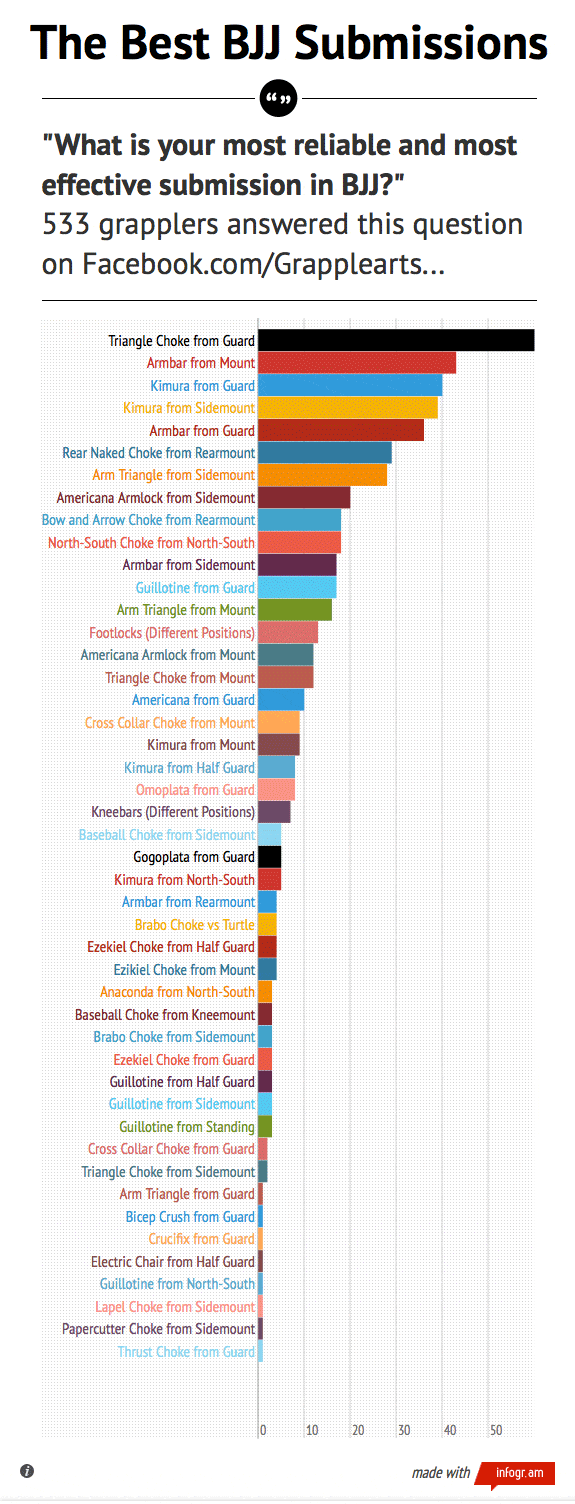What’s the best submission in BJJ? Wow, that’s a tough question! And the first problem is trying to define what we mean by the word ‘best’…
Before we get into semantics and statistics let’s start by agreeing that there are a million different submissions in Brazilian Jiu-Jitsu and Submission Grappling, and that not all of these techniques were were created equal. Some submissions you see on the mats almost every night, and others are more of a once-in-a-lifetime-and-only-on-a-heavily-medicated-opponent kind of deal…
OK, so some submissions work more often than others – that’s pretty obvious. But how do we actually measure which techniques are rocking it on a regular basis in BJJ class?
To get a handle on the best submission we could ask ‘what are the most effective submission in the UFC?‘
People HAVE looked at those statistics, especially in MMA (for an example of this click here). These results are definitely interesting, but they also represent what’s happening for elite athletes not wearing a gi, punching each other in the head, and without a whole lot of time on the ground to work for submissions. And so these MMA-based breakdowns may not be representative of what’s happening on the mats of your average BJJ school…
Or we could ask ‘what are the highest percentage submission in the black belt division of the Mundials?’
This might be getting a little closer to answering the question of what’s the best BJJ submission. And while there have been some very interesting analyses of high level BJJ competition there are still some flaws with this approach…
First of all, only a tiny, tiny percentage of BJJ practitioners are every going to compete in the black belt division of the Mundials. And maybe asking what works in gold medal matches at the Mundials is a bit like asking a jet fighter pilot what the best way to get from New York to Boston is: he might tell you it’s to break the sound barrier in an F-35 Lightning II, which might not be an option for everybody.
Another way to define ‘best’ is to ask what works most often for the most people.
For every single tap out in the UFC there are thousands of practitioners tapping out in BJJ schools and garage clubs every day. I didn’t think it was fair that these ‘regular’ BJJ’ers were being ignored, and that maybe crowd-sourcing this question might give us a better picture of what’s going on for ‘regular’ people training in BJJ.
And so I recently asked the following question on the Grapplearts Facebook page
Doing a little survey here… What technique is your most reliable and most effective submission in BJJ? Tell me 1) the submission name, and 2) which position you apply it from.
Well this question created quite a bit of buzz. Tons and tons of people responded with their most effective submissions, and I also received quite a few emails on this topic as well.
Even though people are still posting their favorite submissions at some point I had to draw a line in the sand, tabulate the results, and share them with you. Check out the infographic below based on the first 533 responses:

Drumroll please! The hands-down winner is the triangle choke from guard. Maybe that’s why so many BJJ schools use the triangle choke in their school symbol.
This shouldn’t be too surprising really; you’re putting your two most powerful limbs in strong anatomical position around your opponent’s neck and squeezing the life out of him – of course this is going to be a high-percentage technique!
If you took this same data, ignored the starting position, and only focused on the final submission itself then the armbar would pull ahead into top position. Again, not too surprising: I’ve tapped out to hundreds and hundreds of armbars over the years and I’m sure you have too…
I did find it surprising was that the Kimura from guard made it into the number three position. I had initially predicted that the finishing percentage for the Kimura would be much higher from sidemount than from guard, but apparently this technique is popular and effective for people regardless of whether they’re on the top of the bottom.
Another weird thing was that people who liked leglocks tended not to say which position they applied them. I know it makes a hash of the scientific rigor of this ‘study’ but to deal with the lack of positional data for leglocks I decided to lump leglocks into two broad categories (footlocks and kneebars) rather than ignore them altogether.
Let me give you some options if you want to share this graphic with your training partners. The easiest way is to hit the Facebook, Twitter or Google + buttons at the top and bottom of this post. But here are some more options for you:
- Here’s the raw data from the original Facebook poll and asking readers about their most effective, most reliable submission – please feel free to reanalyze it any way you see fit!
- Here’s the Best BJJ Submissions graphic on Facebook
- Here’s The Best BJJ Submissions graphic on Infogram which is the program I used to create the infographic.
Finally I think the best part of this whole polling exercise is that it revealed so much diversity between practitioners.
The fact that there is a long tail in the results means that you shouldn’t get discouraged if you’re not a triangle choke and armbar kind of fighter. There are lots of submissions that people make work, and – more importantly – there’s ‘best’ technique for every skill level, body type, and style of game.
Good luck with your training!
Stephan Kesting
Grapplearts.com
The post The Best BJJ Submissions Revealed appeared first on Grapplearts.
